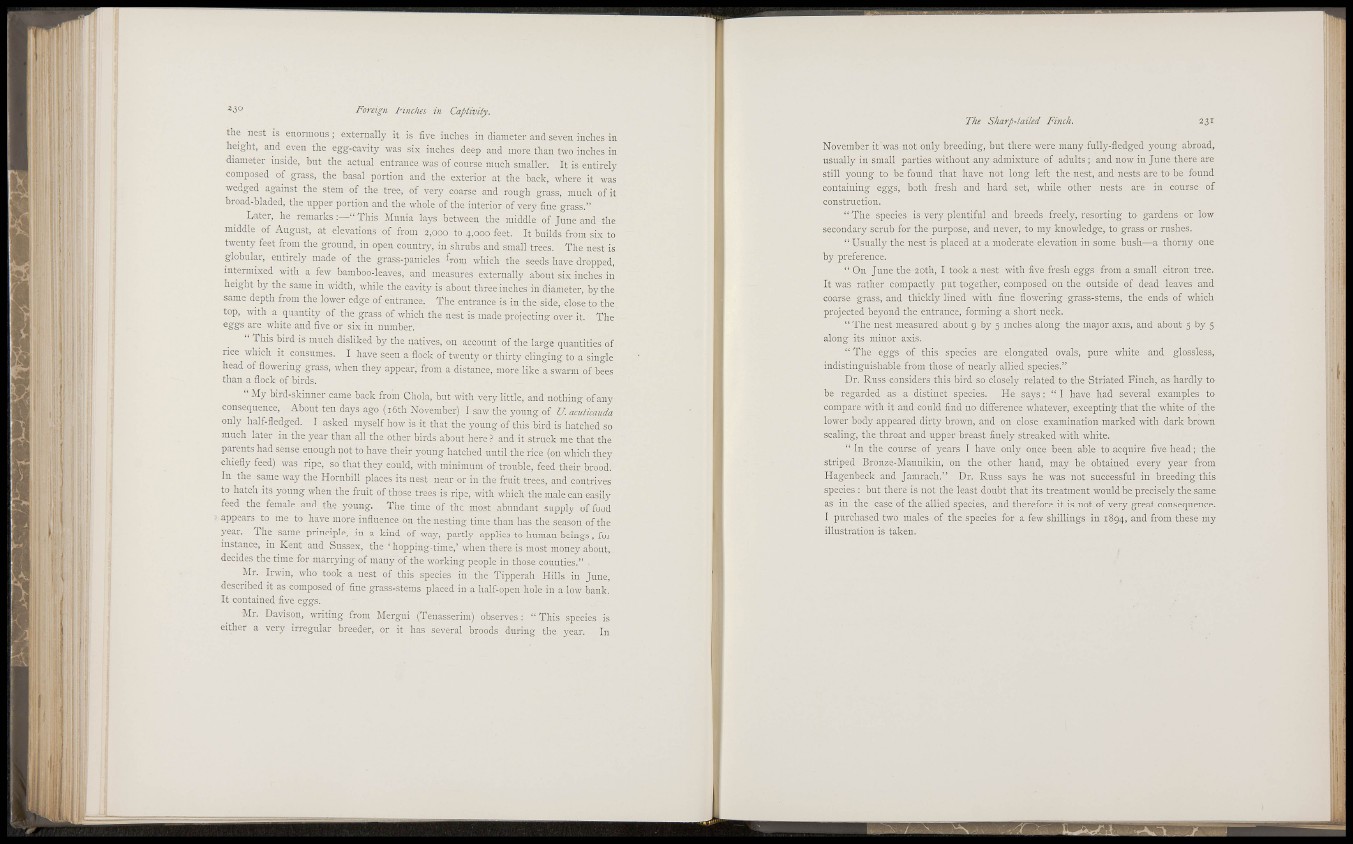
230 Foreign Finches in Captivity.
the nest is enormous ; externally it is five inches in diameter and seven inches in
height, and even the egg-cavity was six inches deep and more than two inches in
diameter inside, but the actual entrance was of course much smaller. It is entirely
composed of grass, the basal portion and the exterior at the back, where it was
wedged against the stem of the tree, of very coarse and rough grass, much of it
broad-bladed, the upper portion and the whole of the interior of very'fine grass."
Later, he remarks :—" This JNiunia lays between the middle of June and the
middle of August, at elevations of from 2,000 to 4,000 feet. It builds from six to
twenty feet from the ground, in open country, in shrubs and small trees. The nest is
globular, entirely made of the grass-panicles from which the seeds have dropped,
intermixed with a few bamboo-leaves, and measures externally about six inches in
height by the same in width, while the cavity is about three inches in diameter, by the
same depth from the lower edge of entrance. The entrance is in the side, close to the
top, with a quantity of the grass of which the nest is made projecting over it. The
eggs are white and five or six in number.
" This bird is much disliked by the natives, on account of the large quantities of
rice which it consumes. I have seen a flock of twenty or thirty clinging to a single
head of flowering grass, when they appear, from a distance, more like a swarm of bees
than a flock of birds.
" My bird-skinner came back from Chola, but with very little, and nothing of any
consequence, About ten days ago (i6th November) I saw the young of U. aaiticauda
only half-fledged. I asked myself ho^A- is it that the young of this bird is hatched so
much later in the year than all the other birds about here ? and it struck me that the
parents had sense enough not to have their young hatched until the rice (on which they
chiefly feed) was ripe, so that they could, with minimum of trouble, feed their brood.
In the same way the Hornbill places its nest near or in the fruit trees, and contrives
to hatch its young when the fruit of those trees is ripe, with which the male can easily
feed the female and the young. The time of the most abundant supply of food
• appears to me to have more influence on the nesting time than has the season of the
year. The same principle, in a kind of way, partly applies to human beings ; for
instance, in Kent and Sussex, the ' hopping-time,' when there is most money about,
decides the time for marrying of many of the working people in those counties."
Mr. Irwin, who took a nest of this species in the Tipperah Hills in June,
described it as composed of fine grass-stems placed in a half-open hole in a low bank.
It contained five eggs.
Mr. Davison, writing from Mergui (Tenasserim) observes : " This species is
either a very irregular breeder, or it has several broods during the year. In
The Sharp-tailed Finch. 231
November it was not only breeding, but there were many fully-fledged young abroad,
usually in small parties without any admixture of adults; and now in June there are
still young to be found that have not long left the nest, and nests are to be found
containing eggs, both fresh and hard set, while other nests are in course of
construction.
" The species is very plentiful and breeds freeljr, resorting to gardens or low
secondary scrub for the purpose, and never, to my knowledge, to grass or rushes.
" Usually the nest is placed at a moderate elevation in some bush—a thorny one
by preference.
" On June the 20th, I took a nest with five fresh eggs from a small citron tree.
It was rather compactly put together, composed on the outside of dead leaves and
coarse grass, and thickly lined with fine flowering grass-stems, the ends of which
projected beyond the entrance, forming a short neck.
" The nest measured about 9 by 5 inches along the major axis, and about 5 by 5
along its minor axis.
" The eggs of this species are elongated ovals, pure white and glossless,
indistinguishable from those of nearly allied species."
Dr. Rnss considers this bird so closely related to the Striated Finch, as hardly to
be regarded as a distinct species. He says: " I have had several examples to
compare with it and could find no difference whatever, excepting that the white of the
lower body appeared dirty brown, and on close examination marked with dark brown
scaling, the throat and upper breast finely streaked with white.
" In the course of years I have only once been able to acquire five head; the
striped Bronze-Mannikin, on the other hand, may be obtained every year from
Hagenbeck and Jamrach." Dr. Russ says he was not successful in breeding this
species : but there is not the least doubt that its treatment would be precisely the same
as in the case of the allied species, and therefore it is not of very great consequence.
I purchased two males of the species for a few shillings in 1894, and from these my
illustration is taken.
' , i
' \ .
if
Sk'-'- •
iff